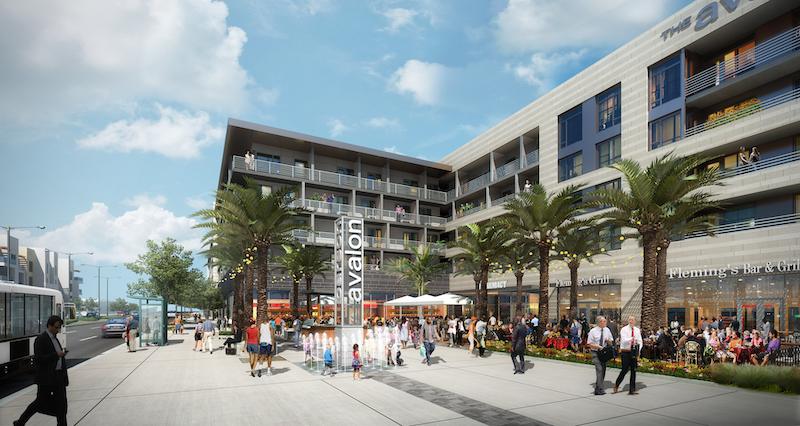Katerra, the Menlo Park. Calif.-based technology company that specializes in prefabricated construction services, is expanding that portfolio through its acquisition of UEB Builders and Fortune-Johnson General Contractors (F-J).
UEB is a GC that specializes in commercial and residential projects such as multifamily, student housing, mixed use, and institutional. UEB can now tap into Katerra’s sales network that includes 11 offices in the U.S. (three of which are in Arizona) and one in Guadalajara, Mexico.
“Katerra reflects what we both believe in,” says Michael Hurst, a Principal at UEB Builders. “A shared desire to find a better way to build for our partners and their communities.” Prior to this merger, UEB had worked with Katerra on a number of projects, including Union South Bay, a 357-unit midrise apartment development under-construction in Carson, Calif.
F-J, founded in 1991, focuses primarily on multifamily construction, but also engages a variety of building types including high-density mixed-use communities, garden-style apartments, senior living, and student housing.
F-J was awarded the 2018 Multi-Family Builder of the Year by the National Association of Home Builders.
Katerra did not disclose the terms of these acquisitions, nor provide specifics about how the businesses would be integrated into its operations, expect to note that through these partnerships, Katerra would gain further construction expertise that will allow the company to expand its geographical footprint across the United States.
“Both companies share Katerra’s commitment to delivering increased value to customers by embracing technology and innovative methods,” says Michael Marks, CEO and co-founder of Katerra.
And given that Katerra owns four architecture firms, it can now present itself to clients as a full-service provider of manufacturing, design, engineering, and construction.
Katerra is focused on speed-to-market construction through such tools as digital technology, offsite manufacturing, and fully integrated building teams. For example, a garden-style multifamily building might take 140 days to complete via conventional construction. In Las Vegas, Katerra initiated K90, an R&D project where it built a 24-unit garden apartment in 90 days, from framing to delivery, leaning heavily on modular and prefabrication for such repetitive areas as bathrooms.
To see a video about K90, click here.
UEB and F-J fall under the oversight of Paal Kibsgaard, who last month joined Katerra as its COO, a new position for the company. Kibsgaard had been chairman and CEO of Schlumberger Ltd., an oilfield services company. He has also served on Katerra’s board for three year.
Kibsgaard is now responsible for Katerra’s U.S. operations, including architecture, engineering, manufacturing, and construction. Kibsgaard is also responsible for international expansion, and the development of new construction technologies.
Related Stories
| Jan 15, 2014
6 social media skills every leader needs
The social media revolution—which is less than a decade old—has created a dilemma for senior executives. While its potential seems immense, the inherent risks create uncertainty and unease.
| Jan 15, 2014
Report: 32 U.S. buildings have been verified as net-zero energy performers
The New Buildings Institute's 2014 Getting to Zero Status report includes an interactive map detailing the net-zero energy buildings that have been verified by NBI.
| Jan 13, 2014
AEC professionals weigh in on school security
An exclusive survey reveals that Building Teams are doing their part to make the nation’s schools safer in the aftermath of the Sandy Hook tragedy.
| Jan 13, 2014
6 legislative actions to ignite the construction economy
The American Institute of Architects announced its “punch list” for Congress that, if completed, will ignite the construction economy by spurring much needed improvements in energy efficiency, infrastructure, and resiliency, and create jobs for small business.
| Jan 12, 2014
The ‘fuzz factor’ in engineering: when continuous improvement is neither
The biggest threat to human life in a building isn’t the potential of natural disasters, but the threat of human error. I believe it’s a reality that increases in probability every time a code or standard change is proposed.
| Jan 12, 2014
5 ways virtual modeling can improve facilities management
Improved space management, streamlined maintenance, and economical retrofits are among the ways building owners and facility managers can benefit from building information modeling.
| Jan 10, 2014
What the states should do to prevent more school shootings
To tell the truth, I didn’t want to write about the terrible events of December 14, 2012, when 20 children and six adults were gunned down at Sandy Hook Elementary School in Newtown, Conn. I figured other media would provide ample coverage, and anything we did would look cheap or inappropriate. But two things turned me around.
| Jan 10, 2014
Special Report: K-12 school security in the wake of Sandy Hook
BD+C's exclusive five-part report on K-12 school security offers proven design advice, technology recommendations, and thoughtful commentary on how Building Teams can help school districts prevent, or at least mitigate, a Sandy Hook on their turf.
| Jan 10, 2014
Resiliency, material health among top AEC focuses for 2014: Perkins+Will survey
Architectural giant Perkins+Will recently surveyed its staff of 1,500 design pros to forcast hot trends in the AEC field for 2014. The resulting Design + Insights Survey reflects a global perspective.
| Jan 9, 2014
How security in schools applies to other building types
Many of the principles and concepts described in our Special Report on K-12 security also apply to other building types and markets.

















